BREAKING NEWS: Science Writer Amy Maxmen Has Been Harassed on Social Media for Crappy Writing, And it Will Likely Happen Again
Does Nature Magazine’s financial ties to the Chinese government explain their tendentious approach to news?
In hindsight, it was as inevitable as another shocking report on human rights abuse in Saudi Arabia. “It took a hell of a lot of personal harassment for me to think about how Twitter shapes media discourse,” tweeted science writer Amy Maxmen, on the horrors she’s encountered for her science writing. “I know my thread may amplify the shit-storm but I’m presenting it as a study and cautionary tale since it is distressing!”
But what happened to Maxmen? Was she ambushed and shot for covering murderers, mafia and drug traffickers? No, that was Dutch journalist Peter R. de Vries, who is now fighting for his life in an Amsterdam hospital.
Was Maxmen the victim of a car bomb for exposing corrupt politicians and organized crime? Again, no dice. That was Maltese crime reporter and activist Daphne Caruana Galizia, who was murdered three years ago when a bomb detonated inside her vehicle as she left her home.
Both journalists reported fearlessly for years on powerful, corrupt forces who harmed and killed people in their home countries. For that, both should be celebrated.
Maxmen, on the other hand, spent months misinforming the public about the possibility that a Chinese lab accident could have started the COVID-19 outbreak. To date, this pandemic has wrecked economies across the planet and four million people have died. And for her dogmatic fact-challenged articles that oddly aligned with the messaging of an autocratic Chinese government, and ignored deceptive statements by eminent scientists, Maxmen has been … harassed on social media.
Let me repeat: Nature Magazine’s Maxmen has been relentlessly—sometimes viciously—harassed on social media for her reporting.
Not that Nature Magazine seems to care much about her reporting. A few weeks ago, I sent Maxmen a note about one of her more peculiar articles, pointing out a factual error she included to help move along her narrative. Maxmen’s narrative is important, because in science writing, crafting a compelling storyline wins more accolades than doing the hard work of reporting and digging up hidden facts.
Especially when those facts take the shine off of science.
But instead of issuing a correction, Nature doubled down, emailing back that Maxmen’s error was not an error, even though her article conflicted with … Nature’s own prior articles and published reports. No, seriously.
But let’s pause the discussion on fact addled reporting for a moment, and highlight that Maxmen really, really cares about science.
From the outbreak’s beginning, people have spotlighted how China misled the world about what it knew and when it knew it. China removed initial warnings on social media about a virus outbreak in December 2019, which Taiwan then reported to the World Health Organization. Chinese officials also forced the doctor who first warned about the virus to sign a statement denouncing himself for spreading rumors, and disappeared early media accounts of the pandemic written by Chinese journalists.
By February 2020, Peter Daszak president of the EcoHealth Alliance, conspired to place a statement in The Lancet that silenced debate over the possibility that the pandemic could have started with an accident in a Wuhan lab: “We stand together to strongly condemn conspiracy theories suggesting that covid-19 does not have a natural origin.” In that statement, Daszak did not disclose that EcoHealth Alliance funds the Wuhan Institute of Virology.
The next month, Nature Magazine published a study that further absolved the Chinese government of a possible lab accident. When Maxmen later covered this study, she did not report that one of the authors, Edward Holmes, was a Guest Professor at the Chinese Center for Disease Control and Prevention in Beijing.
But last January, the State Department announced that the Wuhan Institute of Virology had been conducting dangerous virus research called “gain of function” and had collaborated on secret studies with the Chinese military. And an Associated Press investigation (“Anatomy of a Conspiracy”) found that China had conspired “in spreading foreign disinformation about COVID-19’s origins, as it came under attack for its early handling of the outbreak.”
Yet none of this seems to have bothered Maxmen. Not even when the Director of the National Institutes of Health told the Washington Post that we need to examine the lab notebooks of the Wuhan scientists to confirm that the pandemic did not start because of an accident. “If they really want to be exonerated from this claim of culpability, then they have got to be transparent,” the Director said.
Instead, Maxmen’s reporting and twitter feed have fueled the conspiracy that people raising questions about a possible Chinese lab accident were themselves “conspiracy theorists.”
When evidence pointing to a lab accident or Chinese culpability appeared in news reports, Maxmen responded in two ways:
1) Hard ignore
2) Knock it down!
When Boston Magazine, the Washington Post, and the Wall Street Journal reported on China’s possible culpability in starting the pandemic, Maxmen often chose #1—Hard ignore.
But when Vanity Fair and Newsweek wrote in depth stories that undermined Maxmen’s opinions and favored narrative, she reached for #2—Knock it down!—and attacked the reporters’ alleged sources.
She took the same—Knock it down!—approach as journalists began speaking up about the extended campaign by conflicted scientists to brand people “conspiracy theorists” and silence them from speaking out that the virus could have leaked from a Wuhan lab. Many of these conflicted scientist, not surprisingly, were Maxmen’s favored sources.
But for all her science writing antics, Maxmen is incapable of correcting her own errors.
After she wrote a peculiar article that accused people of bullying, creating divisiveness, and harming the pandemic response by questioning if China may have screwed up and started the pandemic, novelist and screenwriter Walter Kirn responded with derision about Maxmen’s “happy lies” and thanked her for “setting back the entire rationality project ten thousand years or so.”
Maxmen then began turning cartwheels with a second clumsy article that sought to explain how the pandemic started. This forced French scientist Virginie Courtier-Orgogozo to criticize Maxmen’s article for biased reporting that is hurting the scientific community.
Ignoring Maxmen’s bias, I emailed her about an error in the article. To stitch together her tendentious narrative that a Wuhan lab accident was unlikely and that lab leaks were not really a problem, Maxmen wrote, “Although lab leaks have never caused an epidemic, they have resulted in small outbreaks involving well-documented viruses.”
In an email, I pointed out to Maxmen that Science Magazine had published a study noting that an anthrax lab leak had caused an epidemic in Sverdlovsk, Russia. To make it easy, I even included a screenshot of the paper.
What followed was an increasingly bizarre email exchange with Maxmen and her editor, Lauren Wolf. According to Wolf, no correction was needed because Nature had contacted experts who confirmed to them that a lab leak in Sverdlovsk had NOT caused an epidemic. “They say that Sverdlovsk is not an example of a lab leak causing an epidemic, but rather was an industrial accident involving a covert, illegal bioweapons production plant that resulted in a non-infectious, localized outbreak,” Wolf wrote.
I then emailed Maxmen and Wolf that it was not only Science Magazine that had reported on the Sverdlovsk lab leak. Articles can also be found at Frontline (Frontline: The 1979 Anthrax Leak) and Bloomberg (The History of Lab Leaks Has Lots of Entries: Smallpox, anthrax and influenzas have escaped facilities — sometimes with deadly consequences.)
So were Science Magazine, Frontline, and Bloomberg wrong?
No response from Maxmen or Wolf. Crickets.
I then sent Maxmen and Wolf a 2000 article in Nature—their own publication!—that noted that the Sverdlovsk “epidemic” had been caused by a lab accident.
Along with this email, I also demanded that Maxmen and Wolf respond with an answer that makes sense. Was Nature going to correct Maxmen’s article, or go back and correct the Nature piece from 2000?
No response.
What is clear is that Nature is unconcerned that Amy Maxmen has a history of awkward reporting that appears to absolve the Chinese government of possibly starting this pandemic with a lab accident. Nature simply does not care, even when an error is brought to their attention.
Even when that error is confirmed by numerous media outlets including … Nature.
What can explain this? Articles at the New York Times, the Financial Times and Unherd report that the Chinese government has financial influence over Springer Nature, the publisher of Nature and Scientific American. Readers of Nature should be wary of Chinese influence, and Maxmen should stop complaining when people complain about her tendentious science writing.
Maxmen has been a victim of online harassment, but readers have good cause to be suspicious. She remains unrepentant, implying that this controversy will start up once again.

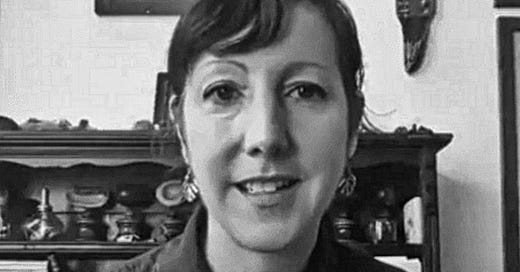





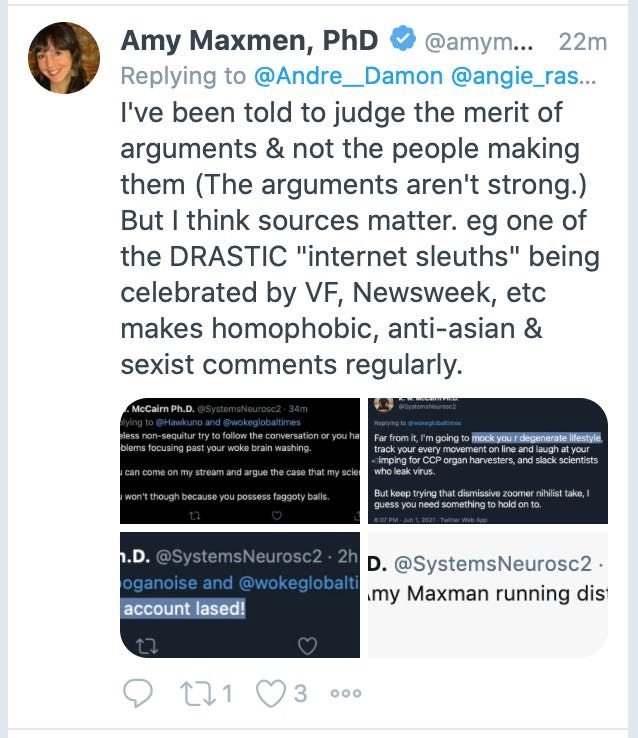

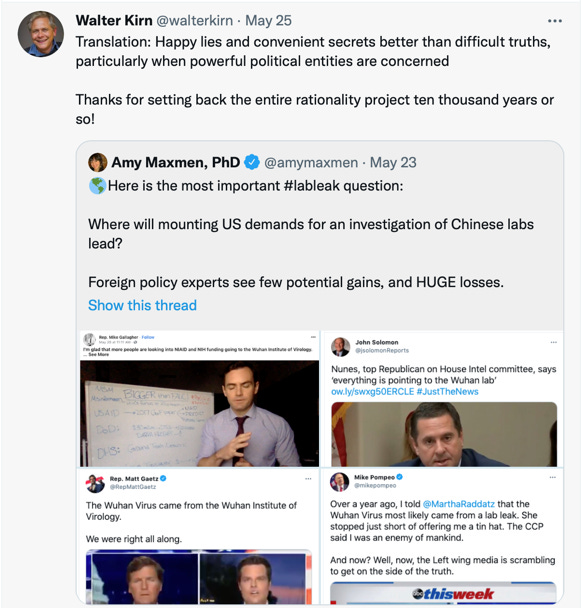
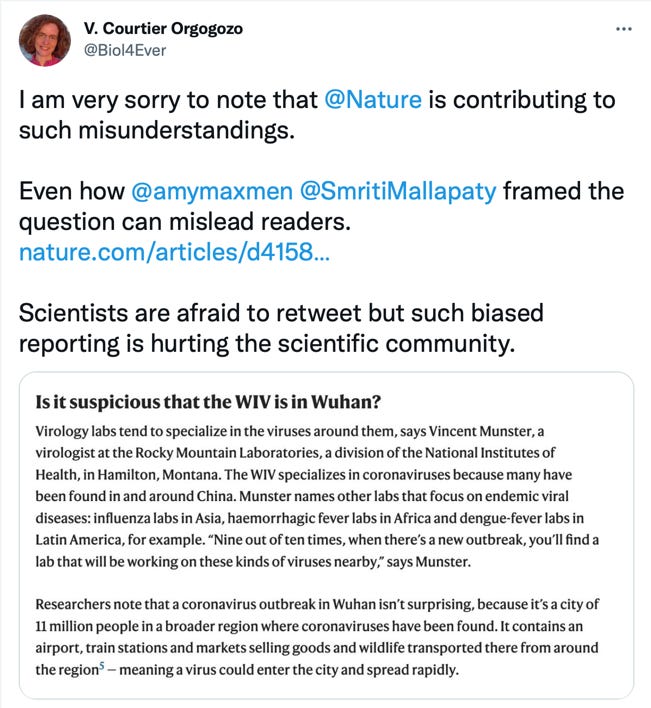

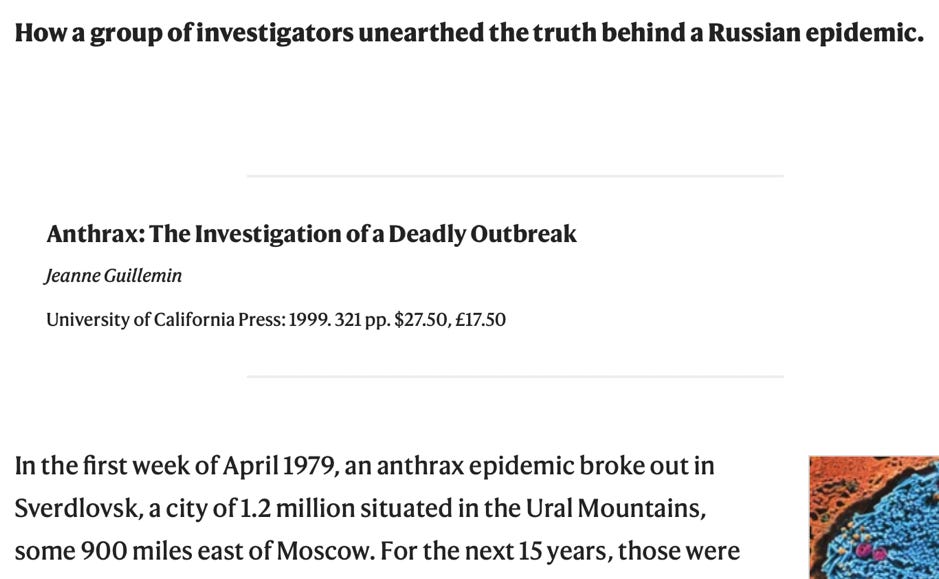

The only reporters who were seriously harassed were those that stuck their neck out to investigate the lab-leak hypothesis, putting their careers and reputations at risk of being destroyed by the Amy Maxmens of this world.
Natute, as with all rigid corporate bureaucracies the mediocre unimaginative types like her tend to fail upwards.
Conflicts of interest and lack of transparency at every level of the medical and media establishment threaten us all. Not only by obscuring facts, which has enormous consequences for individuals, but also, eventually, by destroying trust in shared truth and reality, which deeply undermines cohesion in society.